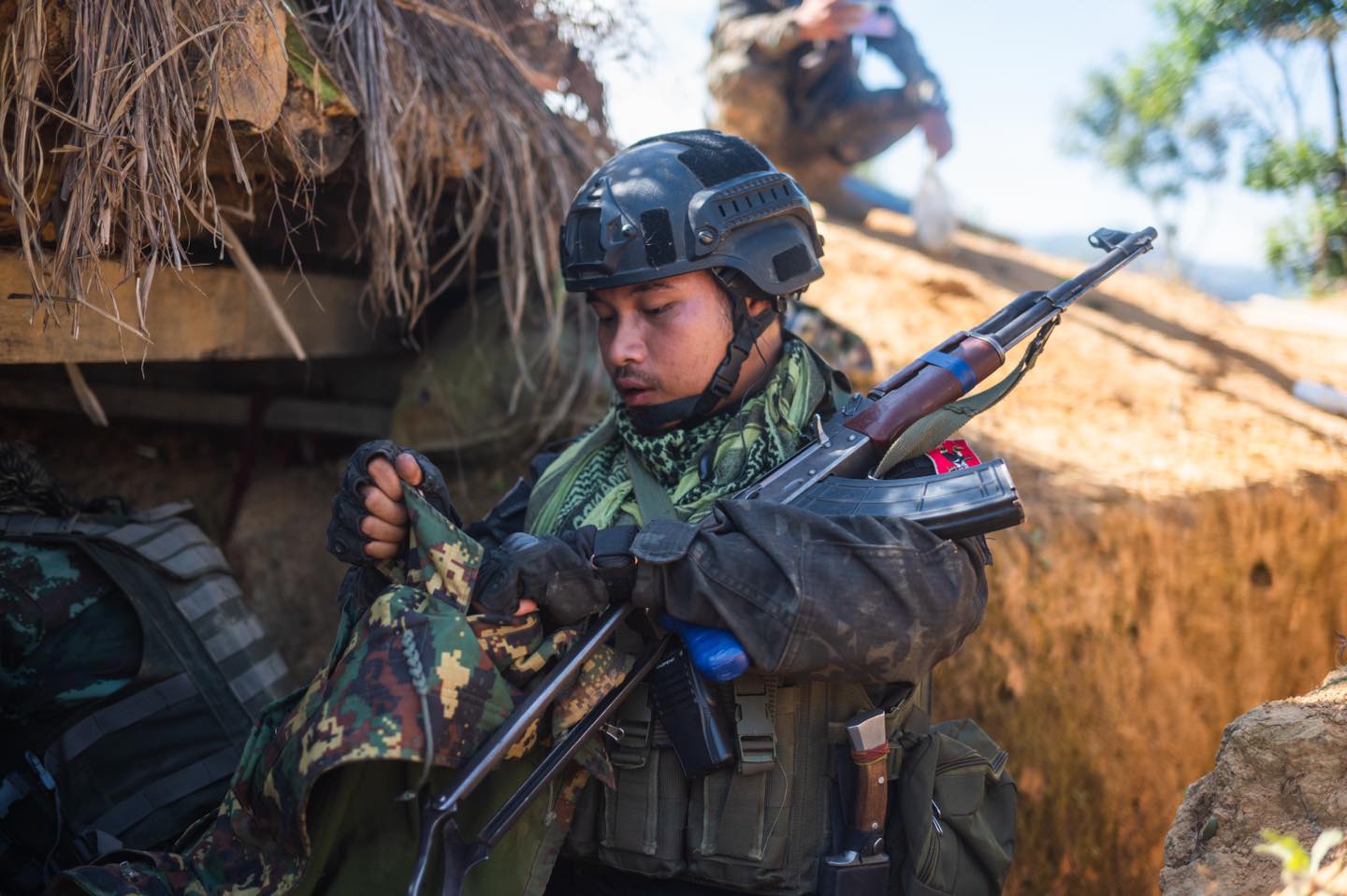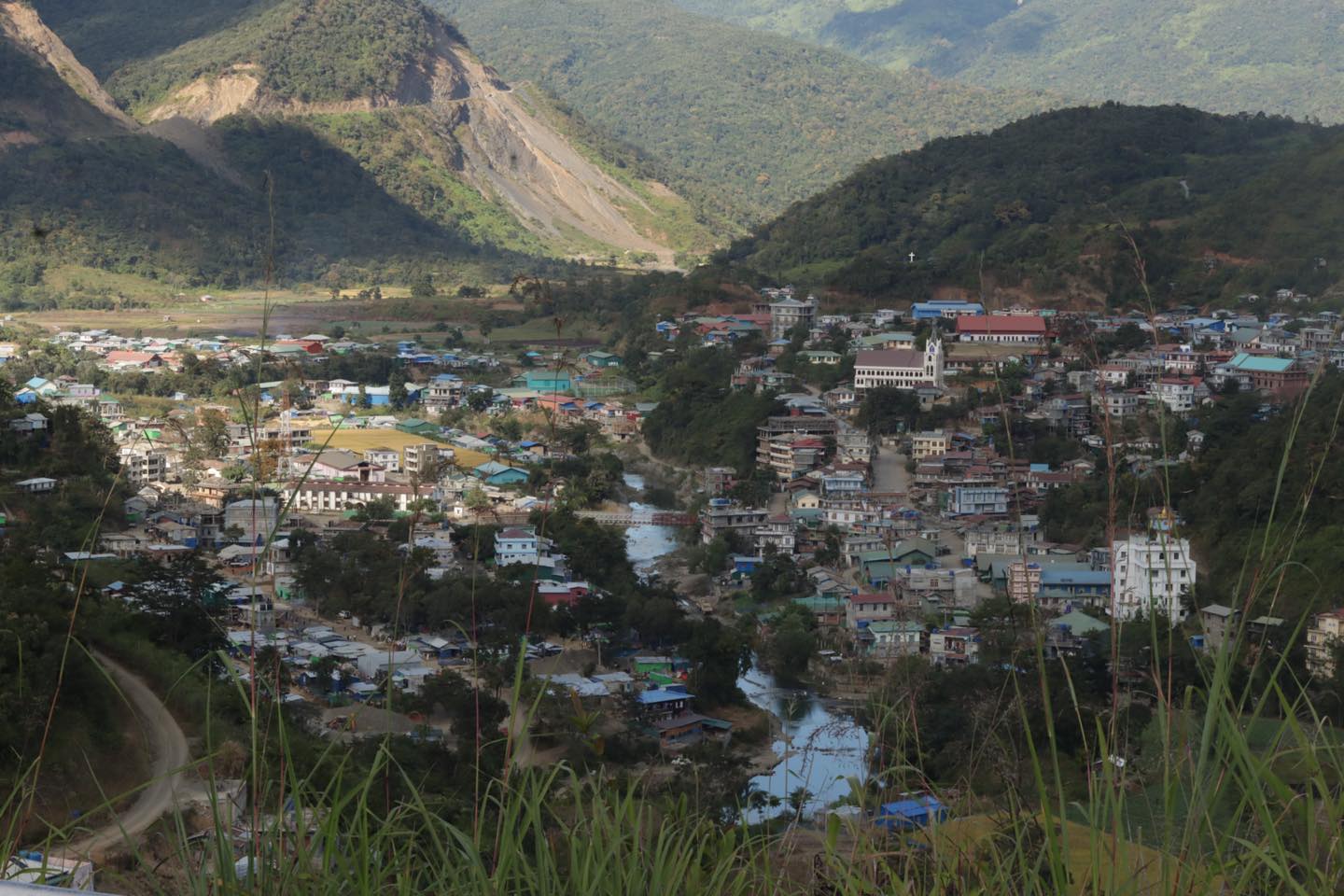In the early morning of Monday, Nov. 13, resistance forces in Chin State, Myanmar stormed two Myanmar military bases near the Indian border. Within hours both were captured, sending 43 junta soldiers fleeing into the Indian state of Mizoram. By the end of the day, the Chin National Army (CNA) flag flew over the crucial border town of Rihkhawdar.
In the tumult of the last few weeks Operation 1027, initiated by the Brotherhood Alliance of ethnic armies in northern Shan State, has sparked the greatest challenge for the junta since it took power in 2021. Besides taking control of border areas near China in northern Shan, resistance forces have overrun dozens of bases and towns in Sagaing, launched Operation 1111 in Kayah, and opened new fronts in Rakhine and Chin states.
Gateway to the northwest
Rihkhawdar is a major milestone for the resistance as it is the first town to fall to the CNA and its allies in Chin State. In the words of a leader in the CNA’s political wing, the Chin National Front (CNF), “Our tactic is from the village to the town to the capital.”
The Rihkhawdar-Zokhawthar crossing is also one of the main overland routes from Myanmar to India. Since the 2021 military coup in Myanmar, thousands of refugees have fled to India through the crossing, staying in camps at Zokhawthar or dispersing throughout Mizoram. Indian and Myanmar citizens making use of the Free-Movement Regime can now travel across the border bridge relatively unmolested, whereas agricultural trade through the gate had often been subject to confiscation from the military. Adopted in 2018, the Free-Movement Regime is a bilateral arrangement that allows residents of border areas who possess a special pass to travel in a zone within 16 km on either side of the border.
However, the significance of the CNA’s capture of the crossing does not come from denying revenue to the military. According to researcher Angshuman Choudhury, border trade over land constitutes less than 1 percent of total bilateral trade between India and Myanmar. The crossing is more significant in its potential to enable material support for the resistance and cross-border aid to displaced people in Chin State. On the Thai-Myanmar border in the country’s east, decades of cross-border aid has built up relatively robust humanitarian infrastructure. By contrast, the northwest is largely cut off.

Despite the crossing’s potential importance, retaking it will be extremely difficult. The military is already overstretched by fighting in different parts of the country, and its rank-and-file soldiers suffer from low morale and insufficient numbers. While the military occupies most major towns in Chin State, resistance forces control the countryside and mountainous terrain in between. Military convoys winding their way through Chin State over the last two years have frequently met with disaster.
True to form, the military has instead lashed out at civilians with air strikes and artillery. On Nov. 15, two military jets bombed the village of Vuilu, which had not seen any fighting, in southern Chin’s Matupi Township, killing eight children and three other civilians. After the CNA and its allies attacked a base in Lailenpi, Matupi on Nov. 19, retaliatory air strikes destroyed a church and killed two civilians. Nevertheless Lailenpi, also near the Indian border, has since fallen under resistance control.
Chin unity and military coordination
The veteran CNA, founded in 1988, is a member of K3C, a group of four ethnic armies aligned with Myanmar’s civilian National Unity Government (NUG). After the coup, the CNA trained the new generation of anti-junta fighters, who went on to form local Chinland Defense Forces (CDFs) across the state. In the battle for Rihkhawdar, the CNA was joined by CDF-Zanniatram, CDF-Hualngoram, the CDF-Thantlang Drone Force, and PDA-Tedim. The capture of Lailenpi included forces from CDF-Thantlang, CDF-Matupi, CDF-Mara, CDF-Lauta and CDF-Zophei.
An array of other Chin groups have also renewed attacks on the military. On Nov. 15, the Chin National Defense Force drove the military from the Tibual camp between Rihkhawdar and the important town of Falam. The next day, the military was forced to abandon the nearby Var military base. On Nov. 21, the Zoland Defense Force took a camp at Kennedy Peak, the second-highest peak in Chin State, which the junta had used to target surrounding towns with artillery.
Despite Chin State’s diversity, encompassing dozens of dialects and local affiliations, these groups share the common cause of defeating the junta. For the past two years, the Chinland Joint Defense Committee coordinated military action across the CNA and 17 member CDFs. These days, the Chinland Regional Committee coordinates the activities of eight regional CDFs, often in tandem with the CNA. Some, such as CDF-Kalay, Kabaw, Gangaw (CDF-KKG), operate in the neighboring regions of Sagaing and Magwe alongside non-Chin armed forces.
The CNA’s close ties with the Kachin Independence Organization/Army, another K3C member, help connect the Chin resistance to the national struggle. Besides training the CNA years ago, the KIA plays a major role in training and fighting alongside the Arakan Army, a Brotherhood Alliance member, in Operation 1027. The KIA also fights alongside the AA and People’s Defense Forces in Sagaing, helping to take Kawlin Township and the town of Khampat near the border of Chin State and India’s Manipur State.
While political unity among the Chin lags behind military coordination, a serious effort to produce state-level administration is well underway. The current round of negotiations has the support of a majority of Chin parliamentarians and armed groups. After two years of talks, sources express confidence that a fully fledged Chinland Council can be established within the next few months. Ideally, this Council will unite the bulk of Chin armies under a single Defense Ministry.
Such a body will also go a long way towards ensuring Chin priorities are heard in the process of building post-junta Myanmar and in conversations with international actors. It would defy the fears in Washington that the resistance remains too fragmented for US nonlethal and technical assistance to make a positive impact.
India’s outdated Myanmar policy

At a time when even China is seen as tacitly approving Operation 1027, largely motivated by the proliferation of scam centers under junta allies, India’s Myanmar policy stands out as an anachronism. At least 75 junta soldiers fleeing to Mizoram have been flown to India’s Manipur State by helicopter and repatriated across the Moreh-Tamu crossing. According to local journalists, these orders came directly from New Delhi after a junta request via the Indian Embassy in Naypyitaw. The Indian government continues to invite junta officials to high-profile events, including junta Education Minister Nyunt Pe at the Global South Summit on Nov. 17.
Continued Indian support for the “mortally wounded” junta is a miscalculation: the military itself is primarily responsible for Myanmar’s chronic instability, dating back to the Ne Win dictatorship. This instability is what forces tens of thousands of Chin refugees into India and allows safe haven for insurgents fighting the Indian government, such as the Manipur People’s Liberation Army, which attacked Indian security forces as recently as Nov. 16. Most strikingly, as junta air strikes and artillery pounded the Chin resistance to prevent Rihkhawdar’s fall, a refugee on the Indian side of the border was killed by stray fire.
This instability also rules out any possibility that India will realize grand economic plans such as the Kaladan Multi-Modal Transit Transport Project, which requires an overland link from India through Chin and Rakhine in the very sites of renewed fighting. Only federal democracy in Myanmar can deliver the border security and regional stability that India needs. Indeed, most of the 5,000 Chin refugees fleeing the junta early this month have already begun returning home through resistance-controlled Rihkhawdar. Engagement with resistance forces now would do a great deal to ensure friendly relations once the junta is defeated.
Recommendations for the US
For Washington too, this transformative moment suggests a need for new policies. With the Indo-Myanmar border now accessible to the resistance, it is past time to bypass the junta and channel cross-border humanitarian aid directly to affected communities. The United States should begin working with India and the United Nations to build aid infrastructure for Myanmar’s northwest. This is also an opportunity to bolster the local administrative capacity of Myanmar’s civilian National Unity Government (NUG) and ethnic resistance organizations, providing a head start on the massive post-revolutionary task of building “federal democracy” from the ground up.
Doubts about resistance unity, which contributed to slow implementation of the BURMA Act, met with a resounding rebuke in Operation 1027. Nonlethal aid and technical assistance for the resistance should be provided without delay; in the past, the NUG has asked for early-warning systems to protect citizens from air strikes, communications equipment, and support for its network of in-country schools. With hundreds of junta soldiers surrendering or joining the resistance since October, the United States should provide funds to incentivize additional desertions. These measures will hasten the end of the war now that the balance has swung decisively against the junta.
Most importantly, Washington needs to come to an accommodation with Myanmar’s neighbors about the post-junta landscape. Despite not drastically changing the character of aid, the BURMA Act raised alarm bells in Beijing that pro-democracy forces might become US catspaws. India and Thailand have their own concerns about the unforeseen consequences of regime change next door. It is imperative for the United States to clearly outline its limited interests and goals in the country, and to work with Myanmar’s neighbors to realize priorities such as infrastructure links and border security. Myanmar cannot finally succeed in its revolution only to become yet another arena of “great-power competition.”
Since the Fiscal Year 2024 budget is held up by congressional dysfunction, new US appropriations for Myanmar will not be possible until early next year. As Congress reconciles the Senate and House versions of FY 2024 appropriations, it should adopt the Senate’s US$167-million Myanmar budget, which explicitly funds cross-border humanitarian assistance through India as well as support for deserters and nonlethal aid for the resistance. In the meantime, the United States should continue to marshal international pressure on the junta and target its finances, as with its sanctions on Myanma Oil and Gas Enterprise.
Zo Tum Hmung and John Indergaard are the executive director and project and advocacy coordinator, respectively, of the Chin Association of Maryland.

















